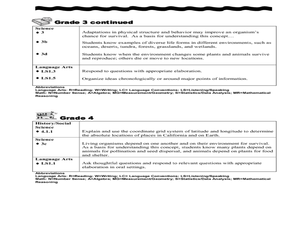Curated OER
The Struggle to Organize
High schoolers analyze correspondence and a news release regarding the Harlan, Kentucky, mine strike of 1931-1932. They use these documents to discuss the problems of organizing industrial trade unions before the New Deal.
Curated OER
Great River Bend Adventure
Students use their imagination. They discuss the 4 C's of teamwork: Concentration, Communications, Coomperation, and Consideration. Students discuss the safety guidelines of the project. They complete a rope maze. The group walks...
Curated OER
Renewable vs. Non-Renewable Resources
Fifth graders identify renewable vs. non-renewable resources and comprehend why conservation of resources is important. They are asked what they think the words natural and resource mean. Pupils then put the words together to define...
Curated OER
Renewable vs. Non-Renewable Resources
Fifth graders, after brainstorming why conservation of resources is important, distinguish between renewable and non-renewable resources. They make a list of different types of natural resources on the board and then sort them into two...
Curated OER
Earth Pockets
Students identify the Earth's natural resources. In this Earth science lesson, students read the book The Great Kapok Tree and discuss types of natural resources. Students use categories such as wood, paper, and trees and list items that...
Curated OER
Sunflowers
Students discuss expressionism, techniques in art, and sunflowers and create original works of "Sunflower" art in this Art lesson plan for all levels and abilities. It is suggested to take the class outside to view sunflowers prior to...
Curated OER
Present Simple Verb Form Worksheet
In this present simple verb and occupations worksheet, young scholars fill in 15 blanks using the verbs given in the key. They fill in the missing words and verbs in a paragraph. They match descriptions of occupations with the proper...
Curated OER
LESSON PLANS (print version) pdf What is a Fossil?
Students can better explain how mould and cast fossils occur when they make their own cast fossils using plaster of Paris and objects such as shells, bone or even their own hand or footprint.







